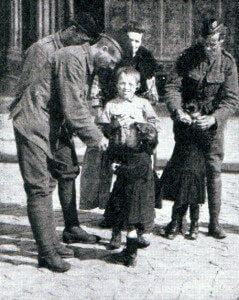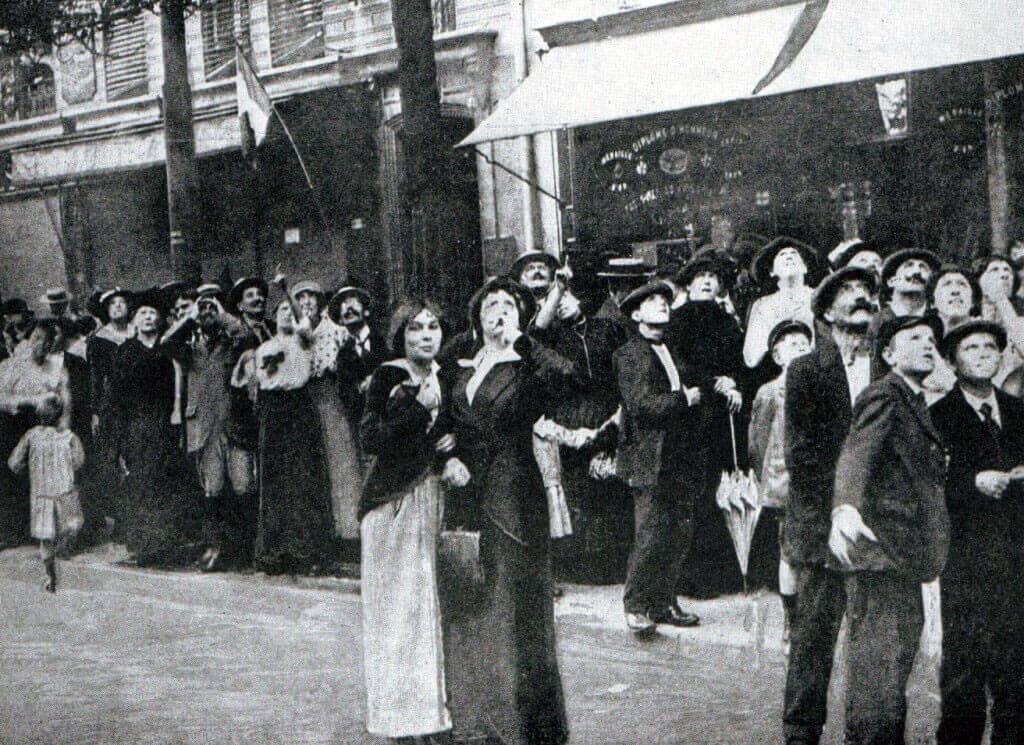The battle, fought from 6th to 9th September 1914 in the First World War, that saw the end of the long retreat by the British and the French armies and the beginning of a successful attack against the pursuing German troops
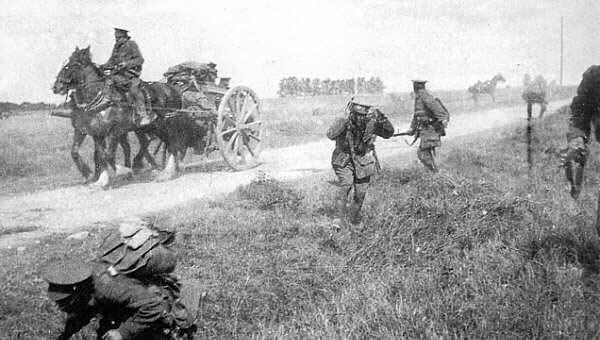
British soldiers of the Middlesex Regiment under shrapnel fire during the Battle of the Marne, fought from 6th to 9th September 1914, during the First World War
The previous battle in the First World War is the Battle of Villers Cottérêts
The next battle in the First World War is the Battle of the Aisne
Date of the Battle of the Marne: 6th to 9th September 1914.
Place of the Battle of the Marne: France, to the east of Paris.
War: The First World War also known as ‘The Great War’.
Contestants at the Battle of the Marne: The British Expeditionary Force (BEF) and the French Army against the German Western Army.
Commanders at the Battle of the Marne: General Joffre commanded the French Army. Field Marshal Sir John French commanded the BEF. General Manoury commanded the French 6th Army. General Franchet D’Esperey commanded the French 5th Army.
Generaloberst von Moltke was the German Chief of Staff and de facto commander of the German Armies in the West under the Kaiser. Generaloberst von Kluck commanded the German First Army, the major German formation facing the BEF.
Size of the Armies at the Battle of the Marne: The German Armies in France were weakened by the need to send 2 Corps to re-enforce the Eastern Front in East Prussia, in the light of the heavy defeat suffered by their Austro-Hungarian allies in Serbia, and their extreme difficulties at Lemburg, where a large Austro-Hungarian army finally surrendered to the Russians.
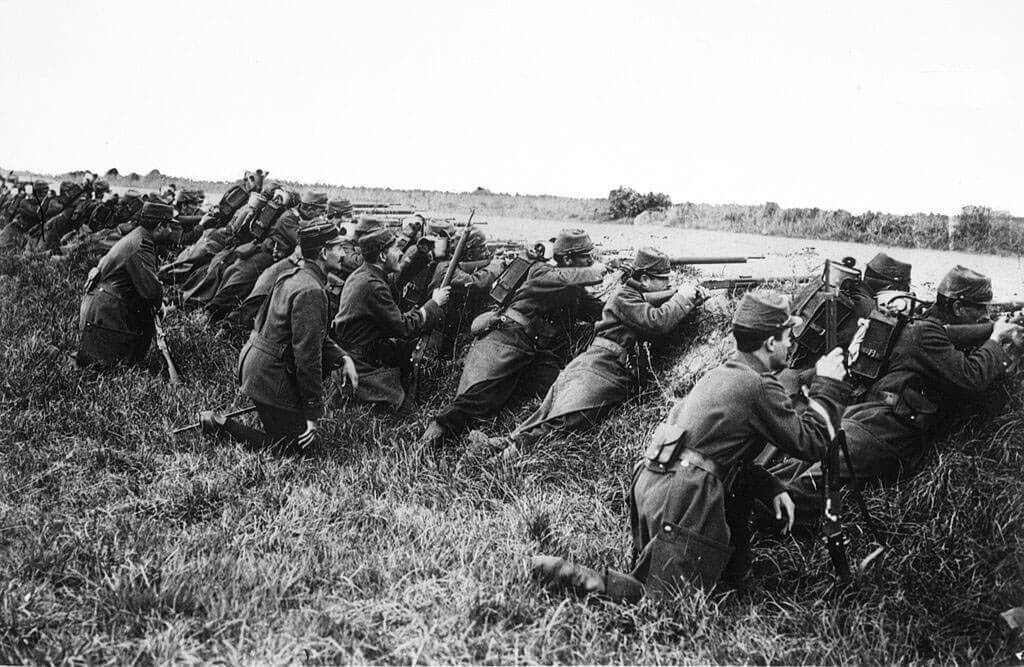
French infantry await an attack during the Battle of the Marne, fought from 6th to 9th September 1914, during the First World War
Winner: The Germans’ triumphant advance through France was halted, and they were pushed back to the Aisne River, taking up the line which broadly remained the front until early 1918. The Battle of the Marne prevented the Germans from conquering France in the first six months of the War.
Uniforms and equipment at the Battle of the Marne:
See this section in the ‘Battle of Mons’ for the BEF order of battle.
Background to the Battle of the Marne:
See this section in the ‘Battle of Mons’.
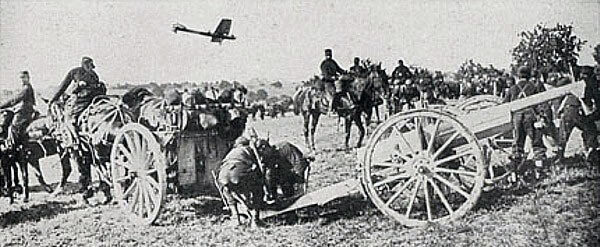
French 75mm field gun, with aircraft in the background, during the Battle of the Marne, fought from 6th to 9th September 1914, during the First World War
Account of the Battle of the Marne:
After the extensive retreat from the Belgian Border, General Joffre, the French Commander-in-Chief, on 5th September 1914, ordered the French to halt, with the intention of taking the offensive along the line, and, in particular launching a attack from the north-east of Paris against the German western flank. Field Marshal Sir John French, the commander-in-chief of the BEF, while not formally under Joffre’s orders, agreed to comply with his directions.
The opportunity for the offensive arose with the change of direction in the advance of General von Kluck’s First German Army from a southerly to a south-easterly direction, as von Kluck moved to attack the western flank of the French 5th Army.
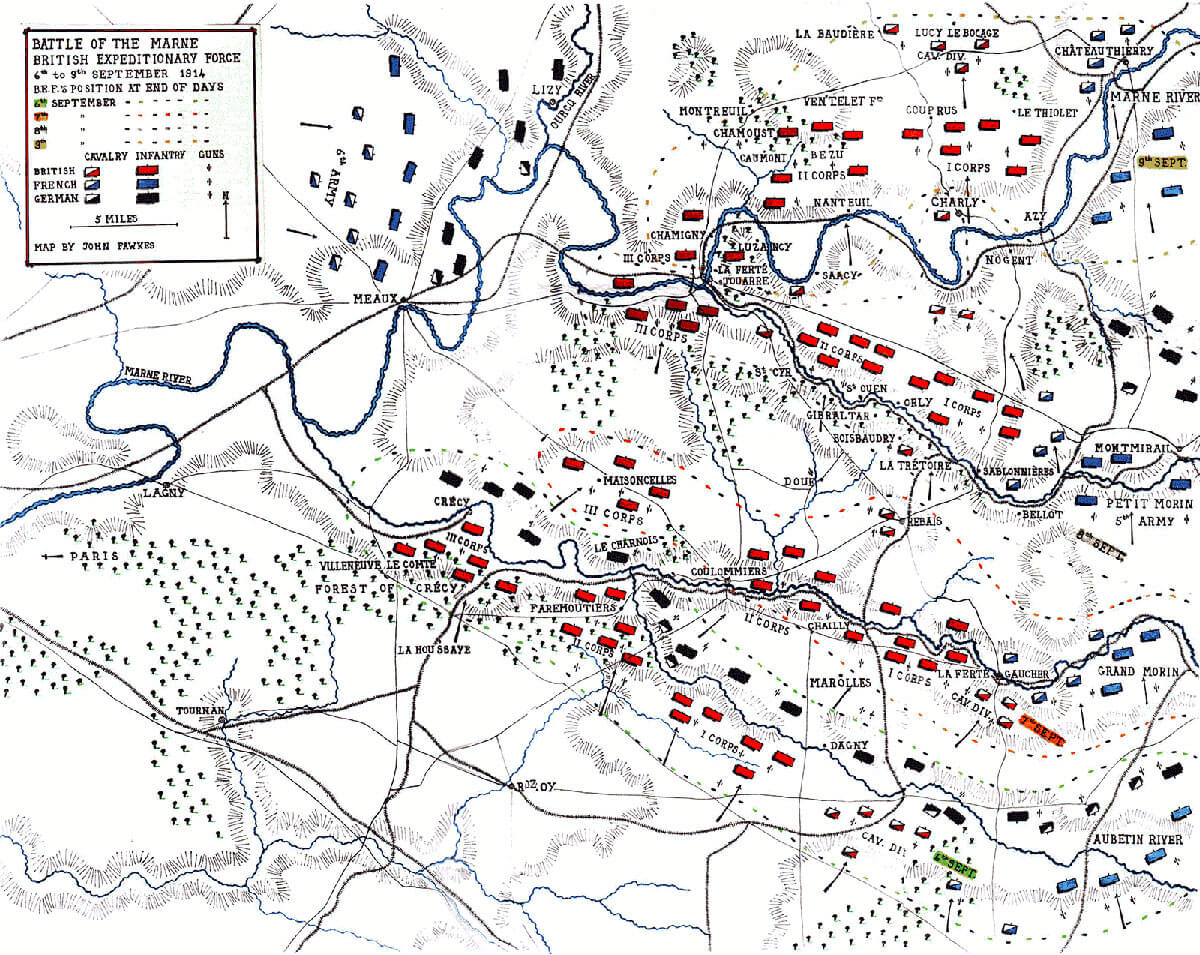
Map of the Battle of the Marne, fought from 6th to 9th September 1914, during the First World War: map by John Fawkes
The German strategy assumed that the BEF was no longer an effective fighting force, and that General Manoury’s 6th Army on the German western flank was no threat, both assumptions to be proved wrong in the Battle of the Marne.
The change for the French and the British, from headlong retreat to precipitous attack, took place on 5th/6th September 1914. The BEF was in a line to the south-west of the Grand Morin and Aubetin Rivers. The French 5th Army was to the east of the BEF. To the north-west of the BEF, the French 6th Army and the Paris garrison were moving east against the flank and rear of the German IV Reserve Corps. Von Kluck’s German First Army faced General Franchet D’Esperey’s French 5th Army. To the east the French line curved north-east to the fortress town of Verdun, and then south towards the Swiss border.
As von Kluck realised that his flank was seriously threatened, he interposed a number of cavalry divisions and mobile units in front of the BEF, commanded by General von der Marwitz, to give his infantry formations the opportunity to withdraw to the Aisne, where the Germans were preparing stronger and more permanent defences. These developments took place over the period 6th to 10th September 1914 during the Battle of the Marne.
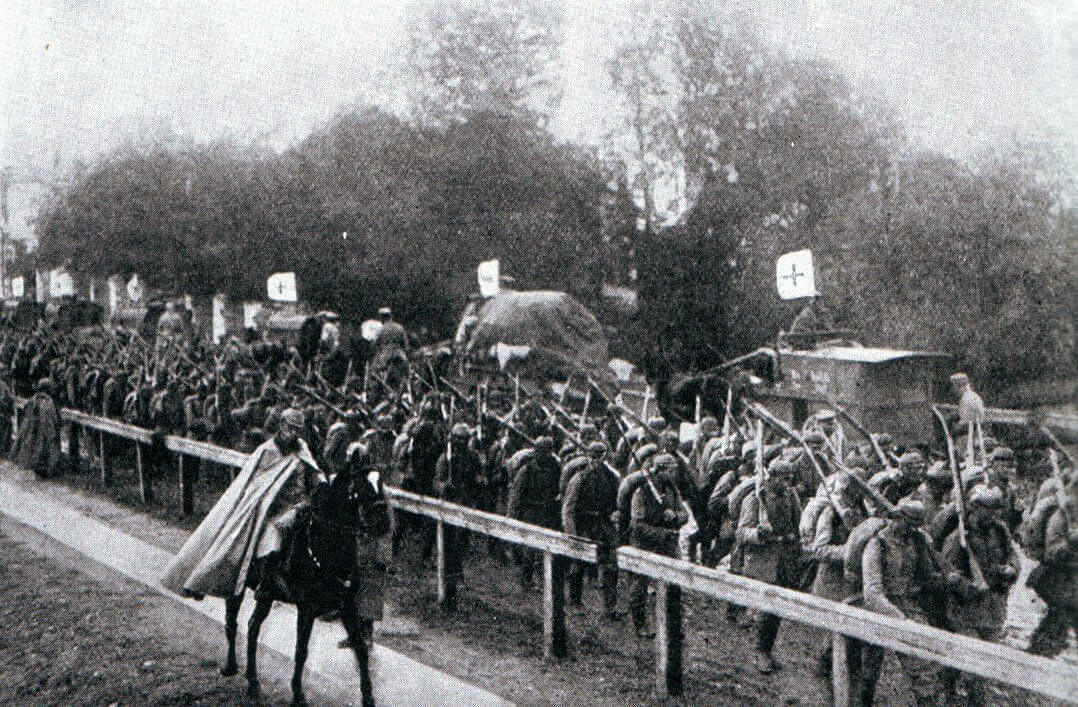
Advancing German infantry pass a Red Cross column: Battle of the Marne, fought from 6th to 9th September 1914, during the First World War
The BEF had, since the Battle of Mons on 23rd August 1914, retreated some 200 miles, during which time, soldiers averaged 3 or 4 hours sleep a night and suffered shortages of food. Discipline was maintained and morale remained high. The BEF fought several battles and skirmishes during the retreat. Casualties were reported as 15,000 killed, wounded and missing. Around 45 British guns had been lost. Most of the losses were suffered by II Corps, at Mons and Le Cateau. 20,000 men were missing from the ranks, but many were lost and would return to their units.
Due to the withdrawal, the BEF base was transferred from Havre and Boulogne to St Nazaire on the Loire. The forward base at Rouen was closed, and the stores transferred to St Nazaire. 20,000 men and 7,000 horses were moved in this operation.
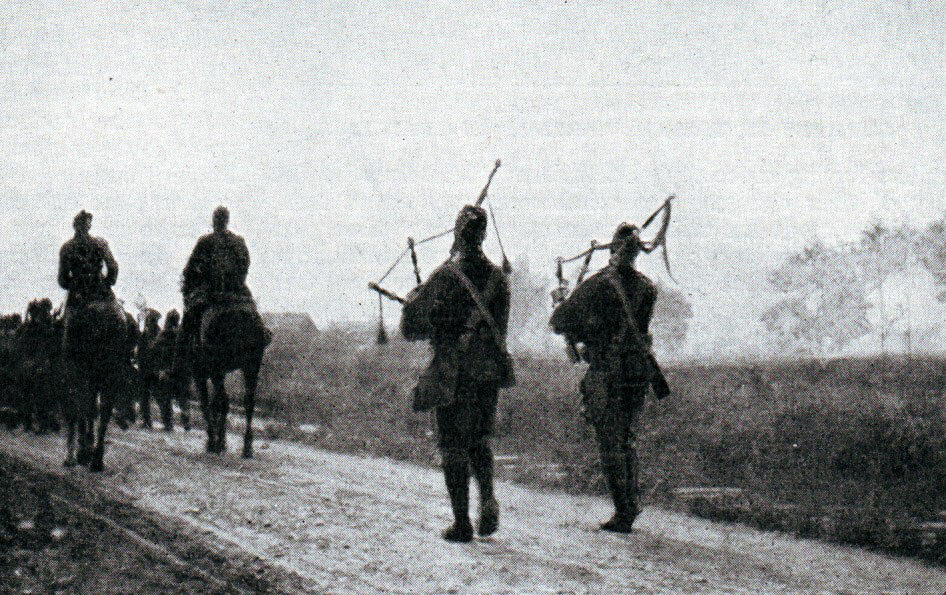
Pipers of the 1st Cameronians during the retreat: Battle of the Marne, fought from 6th to 9th September 1914, during the First World War
But the retreat was now at an end, and the French and British would advance to attack the invading German army, a force now weakened by the transfer of the 2 corps to the Eastern Front.
In the Battle of the Marne, the BEF fought up to and across a number of rivers; the Aubetin, the Grand Morin, the Petit Morin and finally the Marne itself. The Marne is a major river and substantially wider than the others. The Petit Morin River is narrower than the Grand Morin. The Aubetin, flowing into the Grand Morin, is the smallest of the rivers that the BEF had to cross. The country between the rivers is hilly, and the area south of the Grand Morin was substantially wooded.
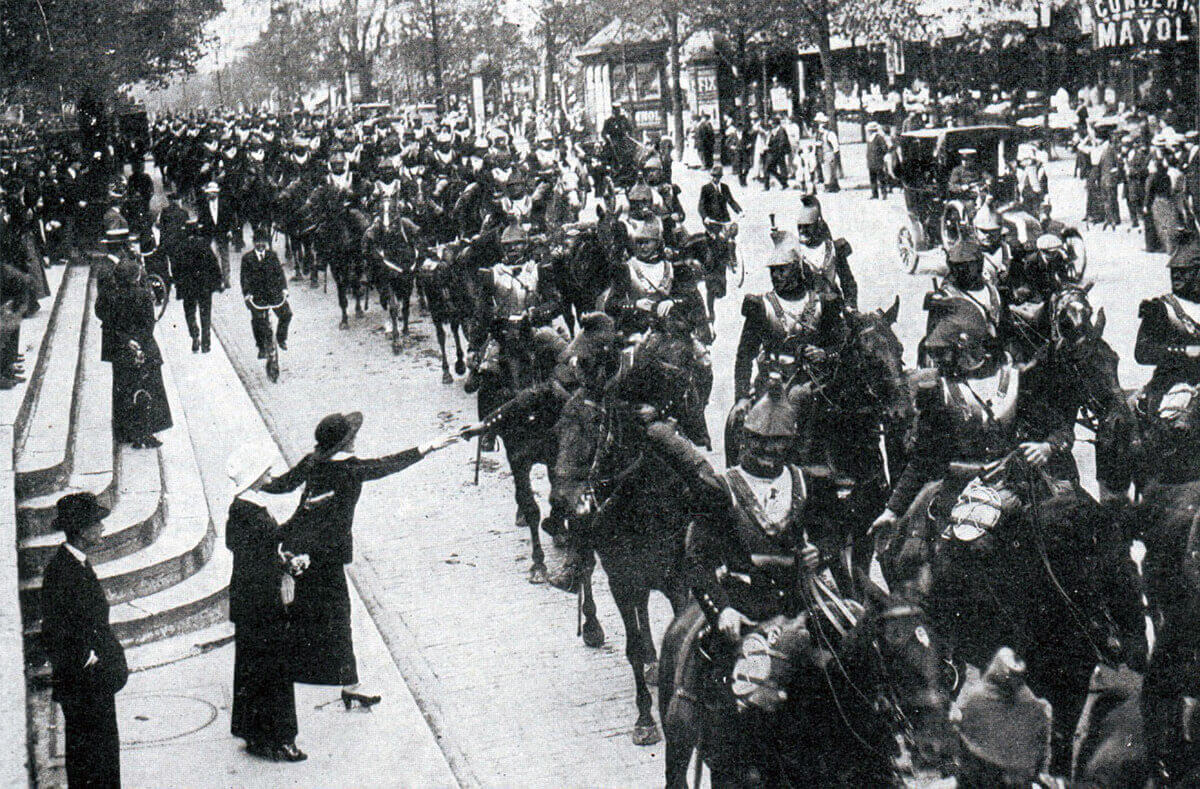
French cuirassiers passing through Paris in 1914: the girl giving the flower is said to have been British: Battle of the Marne, fought from 6th to 9th September 1914, during the First World War
5th September 1914:
In the early hours of 5th September 1914, General Joffre issued his instructions for the offensive. The French armies in the centre and on the right, in the line south-east from Verdun to the Swiss border, were to remain in that position. The three armies on the left were to go on the offensive; Manoury’s French 6th Army and I Cavalry Corps advancing from Paris, the British Expeditionary Force (BEF) advancing north east, and Franchet d’Esperey’s French 5th Army advancing north, to and across the Marne River and then on to the Aisne River.
The timing of the new order caused some difficulty. The BEF and some of the French 5th Army units were already under way, marching away from the Germans, when Joffre’s instructions reached the senior headquarters. The retreating BEF formations were left to finish the day’s journey, and rest up, before returning over the ground they had just covered. Many of the 5th Army units could be and were halted during the day.
At 9am on 5th September 1914, General Manoury arrived at GHQ and explained to Field Marshal French his plan of attack, to be launched from a position west of the River Ourcq early the next day, 6th September. Sir John French promised the support of the BEF.
At 2pm, General Joffre arrived at GHQ and begged British support for the attack ‘In the name of France’. Sir John French again promised that the BEF would do all it could in the operation.
6th September 1914:
The advance of the BEF began in the early hours of 6th September, bringing the BEF up to a line parallel with and a few miles south-west of the Grand Morin-Aubetin Rivers line. As the units advanced, contact was made with powerful German formations.
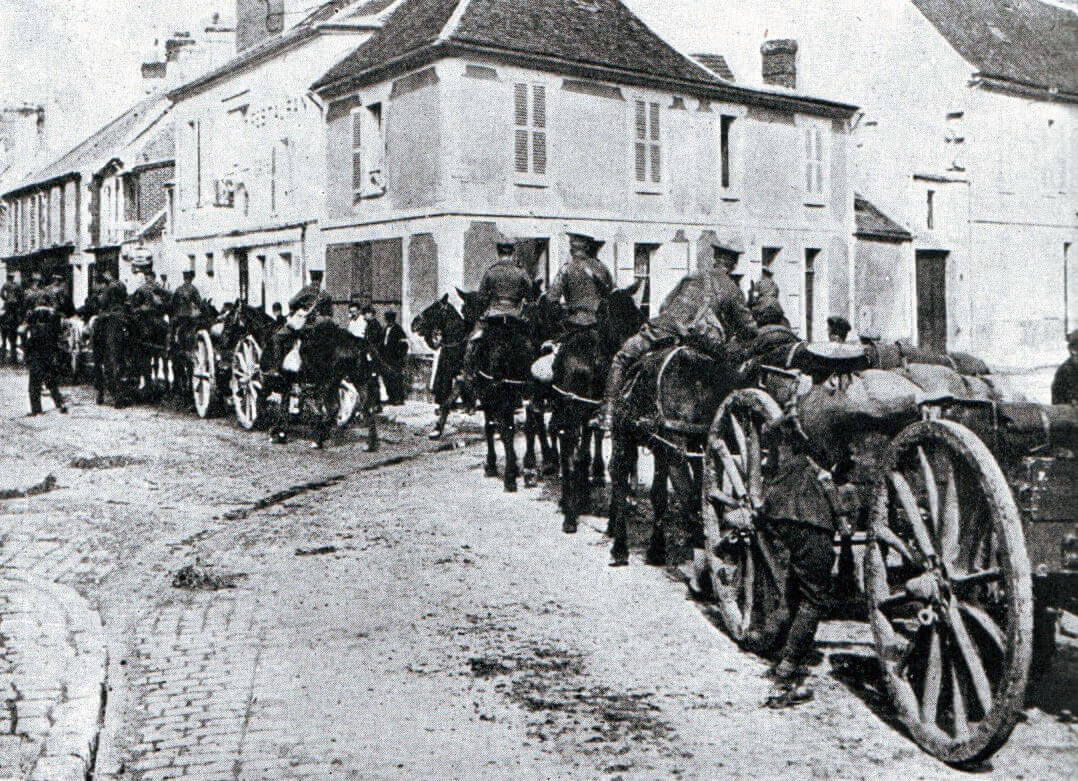
British transport during the advance to the Marne River: Battle of the Marne, fought from 6th to 9th September 1914, during the First World War
The British I Corps was coming up in the area of Rozoy, the 1st (Guards) Brigade finding themselves heavily engaged. General Haig halted I Corps while it was determined whether the Forest of Crecy, to his front, was occupied by German formations.
The British II Corps, on Haig’s left, reached the area around La Houssaye during the late morning of 6th September, and the British III Corps arrived at Villeneuve Le Comte at the same time. These two corps, continuing their advance, caused the Germans to fall back, and I Corps was enabled to resume its own advance.
Royal Flying Corps reconnaissance flights found that the British front was clear of German troops. Several of the German formations that had been engaging the BEF, were now deployed across the Ourcq River, facing General Galliéni’s troops at the left end of the Allied line, on the northern side of the Marne River.
The German troops still facing the BEF were parts of II and IV Corps, and several cavalry divisions.
At 3.30pm, Sir John French ordered the three corps of the BEF to move forward to positions around 5 miles short of the Grand Morin River, between Marolles and Crecy, with the Cavalry Division on the right flank, in the area south-west of la Ferté Gaucher.
Some of these orders were received too late for much progress to be made that day.
However in the British II Corps area, in the centre, 7th Brigade of 3rd Division reached Faremoutiers, and at 11pm, 1st Wiltshires forced a crossing of the Grand Morin, seizing the heights of Le Charnois, a mile north of the river.
By the end of operations for the day, the advanced units of the British II and III Corps were on the Grand Morin River, while I Corps and the Cavalry Division, on the right, were still short of the Aubetin River.
Allied intelligence assessments put the German III and IX Corps with the Guard Cavalry Division opposing the French 5th Army, to the east of the BEF, and parts of the German II and IV Corps, with the 2nd, 5th and 9th Cavalry Divisions, opposing the BEF, in the area between the Grand Morin and Petit Morin Rivers.
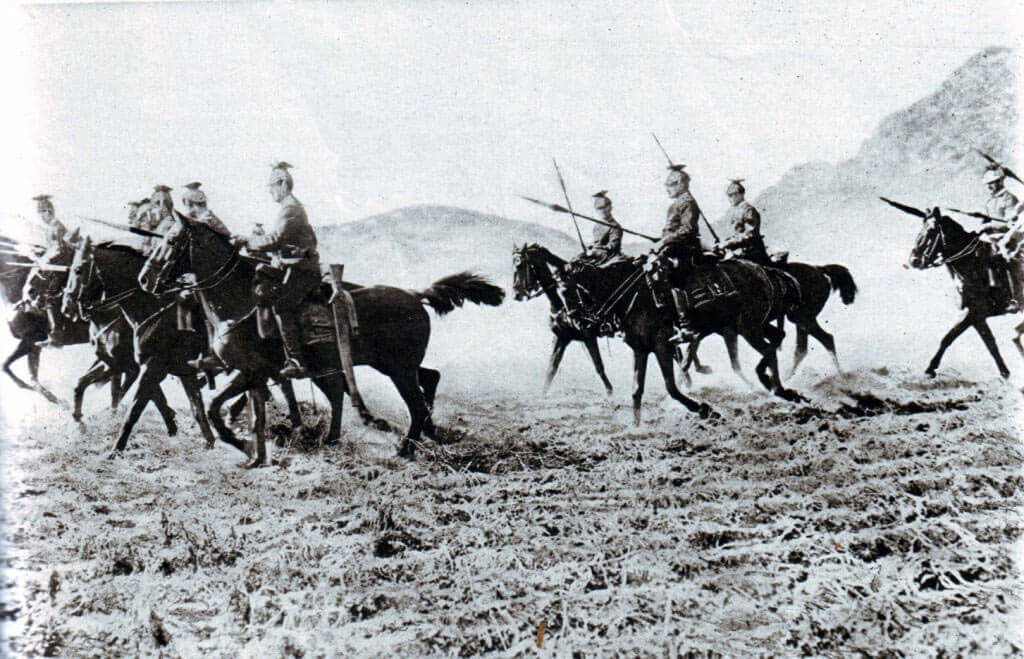
German Uhlans advancing to the attack: Battle of the Marne, fought from 6th to 9th September 1914, during the First World War
The French 5th Army was reported by the British air patrols to be pushing the Germans back, on the BEF’s eastern flank. Similar patrols reported that to the north-west, the French 6th Army was attacking the Germans on the western side of the Ourcq River.
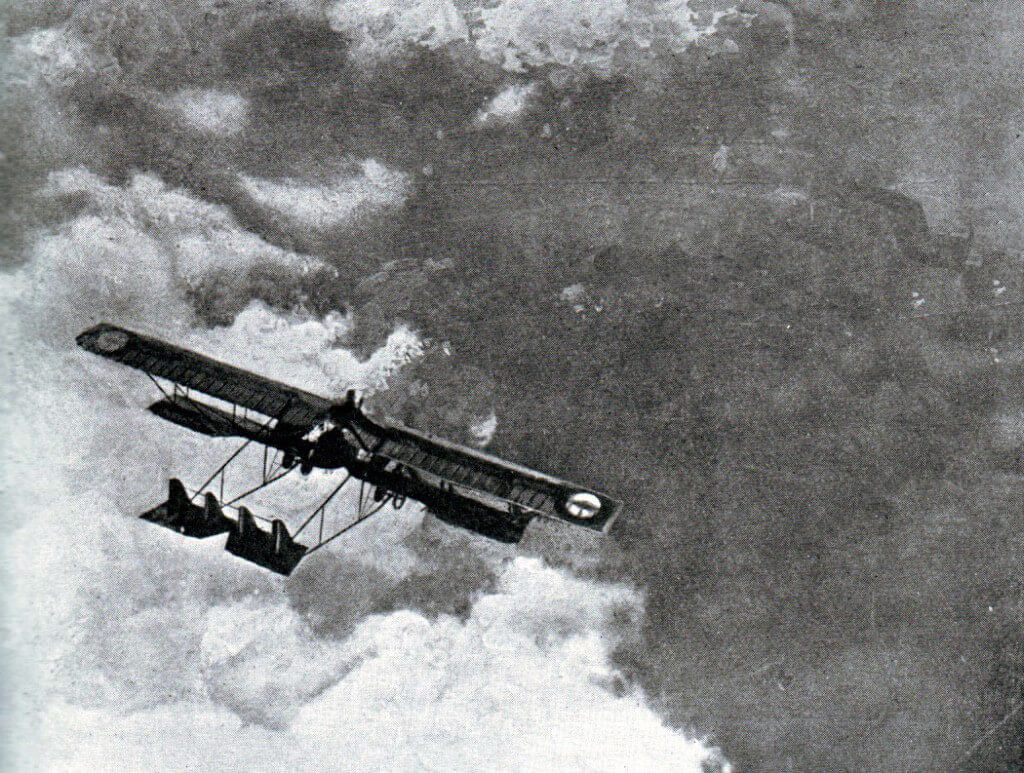
French aircraft: Battle of the Marne, fought from 6th to 9th September 1914, during the First World War
Sir John French issued no advance orders for the next day, other than that all units should be ready to move at short notice. During the night the last of the casualty replacements reached the forward units from Britain.
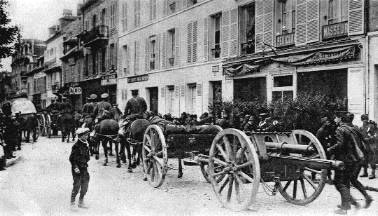
British Royal Field Artillery 18 Pounder Battery moving through a French Town: Battle of the Marne, fought from 6th to 9th September 1914, during the First World War
7th September 1914:
Late on 6th September, General Joffre, the French Commander-in-Chief, issued a directive that the advance should be angled towards the North, rather than to the North-East, its direction on the previous day. This request did not reach the BEF HQ at Melun until late in the morning of 7th September.
The BEF units were on the move early in the day, the 5 cavalry brigades approaching the Grand Morin River in the area to the south of a line from Coulommiers to la Ferté Gaucher.
The 9th Lancers moved into the town of Dagny, on the Aubetin River, leading 2nd Cavalry Brigade. The commanding officer of the 9th Lancers, Lieutenant Colonel Campbell, with his headquarters troop, was charged by a squadron of the German 1st Guard Dragoons. The covering machine gun immediately jammed, leaving Colonel Campbell with no option but to meet the German squadron’s charge. The lancers attacked at a full gallop, and the German horsemen, making the charge at a trot, were overwhelmed.
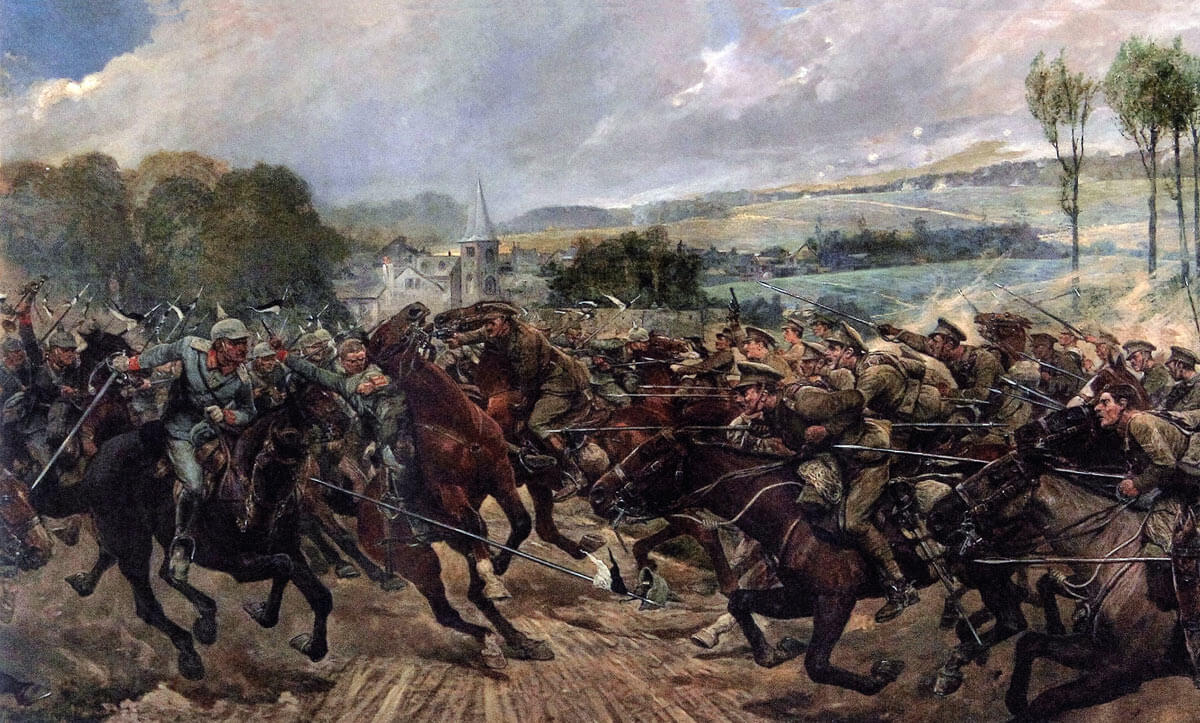
Lieutenant Colonel Campbell charging the German squadron with his troop of 9th Lancers, on 7th September 1914, during the Battle of the Marne, fought from 6th to 9th September 1914, during the First World War: picture by Richard Caton Woodville
Further to the right, a squadron of the 18th Hussars met a German cavalry charge with dismounted rifle fire, annihilating the attacking Germans.
At around 6am, the 1st Wiltshires were attacked in their positions to the north of the Grand Morin River, in the area of Le Charnois, by two dismounted squadrons from the Guard Cavalry Division, which they drove off without difficulty. 2nd South Lancashires, coming up in support, were engaged by German troops in the woods and suffered loss.
By 7am, cyclist and aeroplane patrols established that there were no longer any German units within 3 miles of the Grand Morin River in the area of Crecy. There were still substantial bodies of German infantry and cavalry to the north of the river at la Ferté Gaucher.
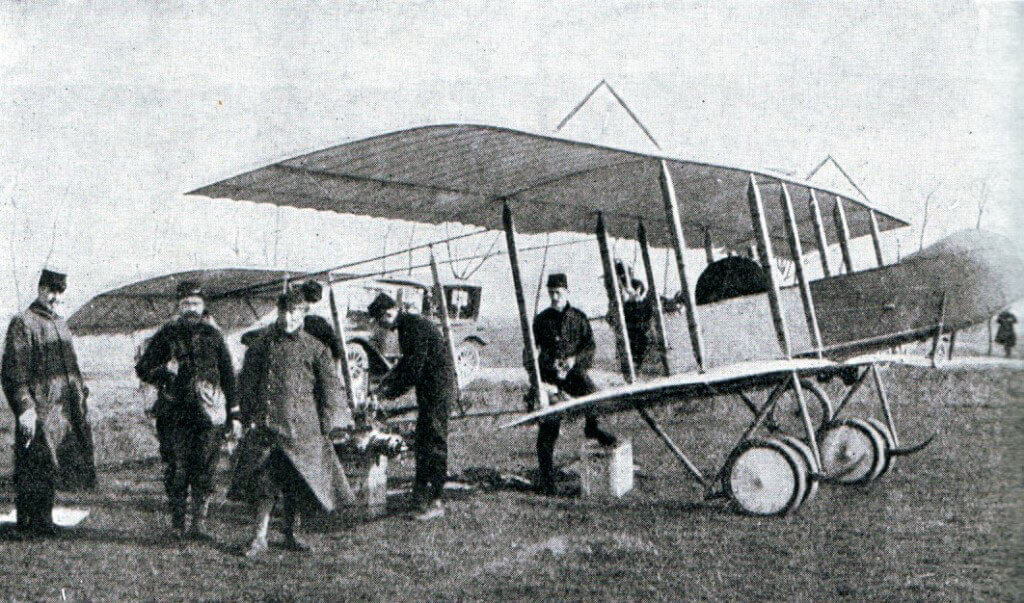
French aircraft being repaired in the field: Battle of the Marne, fought from 6th to 9th September 1914, during the First World War
At 8am, Sir John French ordered the BEF infantry corps (I, II and III) to advance north east in the direction of Rebais, partly crossing the Grand Morin River, and halt on the line Dagny-Coulommiers-Maisoncelles, for further orders.
The Cavalry Division secured the course of the Grand Morin River as far east as la Ferté Gaucher, and then pushed on to Rebais. The 3rd Cavalry Brigade advanced on Coulommiers, meeting resistance at the river crossing, and bringing its guns into action. Advancing along the road to Doue, 3rd Cavalry Brigade was halted by German infantry and machine gun fire.
The British infantry advanced behind the cavalry screen, and encountered clear signs of a disorderly retreat by the German troops. Large numbers of empty bottles lay around the villages, and four incapably drunk German soldiers were found in a haystack near Chailly, by a driver from 48th Battery RFA collecting feed for his horses, who took them prisoner.
On the eastern flank, General Haig brought the right of I Corps up to the Grand Morin River, to make contact with the French 5th Army.
The 7th September saw the BEF advance around 7 to 8 miles, ending the day with its formations along the Grand Morin River, some on the south bank and some on the north, from la Ferté Gaucher west to Maisoncelles.
The French 5th Army to the east of the BEF, lay along the Grand Morin River, again on the north and south banks. The French 6th Army, to the north-west of the BEF, was within 5 or 6 miles of the Ourcq River, with the German formations opposed to it falling back to the east of the Ourcq.
Sir John French issued orders for the next day’s advance to the Petit Morin River and then on to the Marne River.
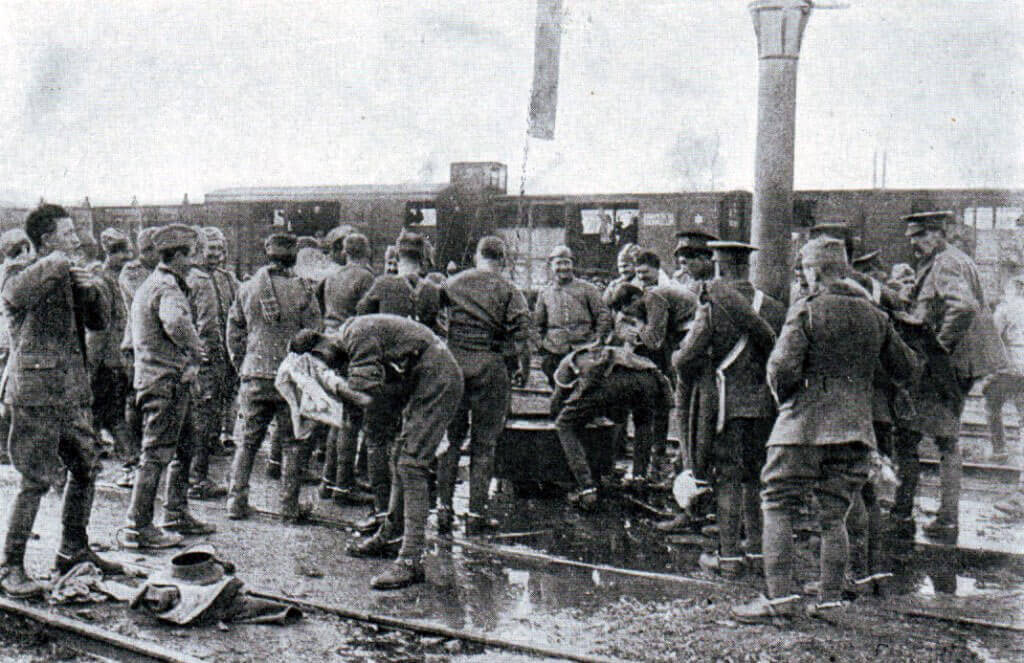
British troops washing in a French station: Battle of the Marne, fought from 6th to 9th September 1914, during the First World War
8th September 1914:
On 8th September, von Kluck ordered his commanders to make a stand on the Petit Morin River, in the expectation that his II Corps could repel General Manoury’s French 6th Army on the Ourcq River to the north-west, and General Bülow could throw back the French 5th Army.
The British Cavalry Division moved out at 4am on 8th September, covering the I and II Corps, heading for the Petit Morin River, directly north from la Ferté Gaucher to Sablonnières.
The 4th and 5th Dragoon Guards led the 1st and 2nd Cavalry Brigades into the valley of the Petit Morin, and attacked the bridges over the river. Both were held up by dismounted cavalry troops holding barricades on the bridges and in the surrounding houses.
The 3rd and 5th Cavalry Brigades, under Brigadier Gough, operating independently, came up to the Petit Morin River to the west of the Cavalry Division.
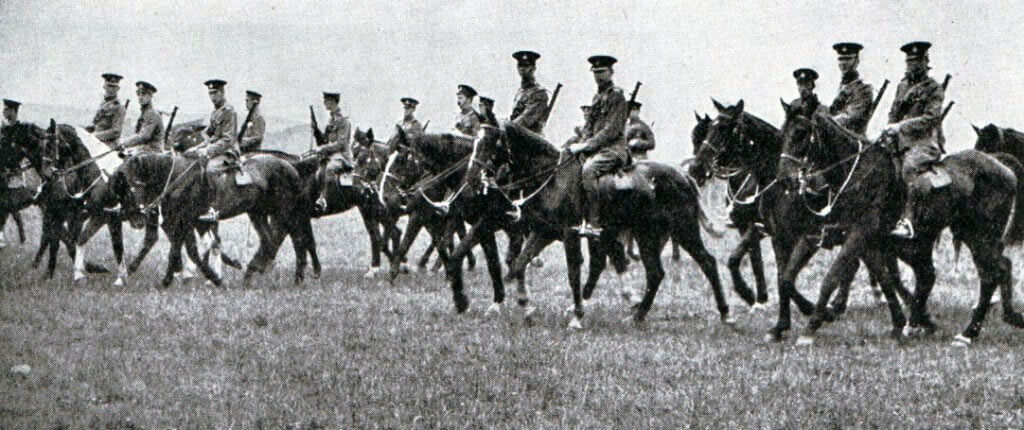
British cavalry in 1914: Battle of the Marne, fought from 6th to 9th September 1914, during the First World War
The Royal Scots Greys came upon a German cavalry brigade eating its breakfast in the oddly named village of Gibraltar. A section of J Battery RHA came into action, and dispatched the German brigade back across the valley.
German counter-attacks and supporting artillery fire brought the advance of the British cavalry to a halt by around 8.30am, leaving the Germans in position along the Petit Morin River.
Further west, at la Ferté sous Jouarre, the German 5th Infantry Division was pulling back across the Marne River, at the point where the river joins the Petit Morin River, the southern bank being held by the German 2nd Cavalry Division and four Jӓger battalions. Substantial German positions formed a semi-circle in the hills to the north of la Ferté sous Jouarre.
To the west of la Ferté sous Jouarre, from 6am, the British 12th Brigade of 4th Division and the independent 19th Brigade, both of III Corps, advanced into the Marne valley, clearing the wooded countryside of bodies of German troops in the process.
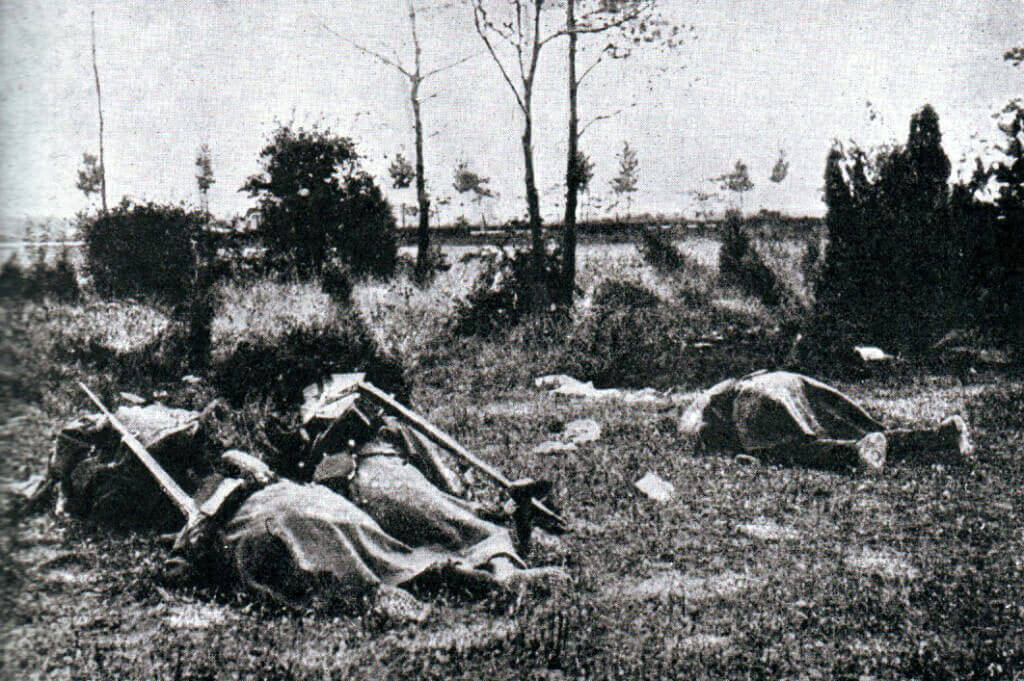
German casualties from machine gun fire: Battle of the Marne, fought from 6th to 9th September 1914, during the First World War
The 19th Brigade moved onto the ridge above the Marne, and came under artillery fire from across the river. Two British batteries returned this fire, but it was clear that it would take a substantial assault to cross the Marne in the face of the German troops defending the northern bank, and those occupying la Ferté sous Jouarre.
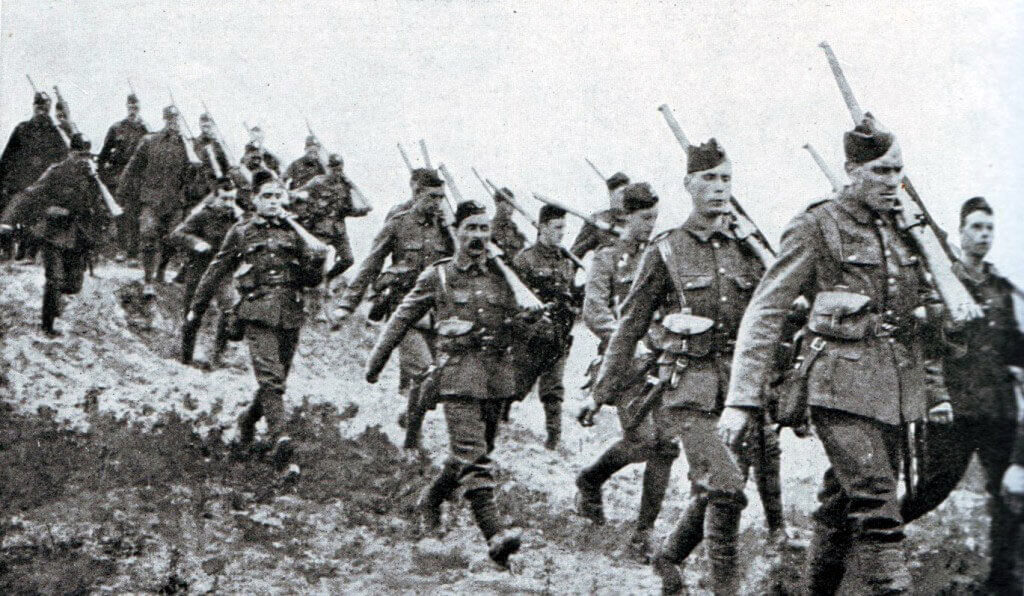
1st Cameronians of the British 19th Brigade advancing during the Battle of the Marne, fought from 6th to 9th September 1914, during the First World War
At the eastern end of the BEF line, 1st Black Watch (of 1st Guards Brigade, 1st Division, I Corps) and 117th Battery RFA advanced to Bellot at 9.30am, and pushed across the Petit Morin River, in the face of heavy German artillery fire, with the support of 118th and 119th Batteries RFA and assisted by French cavalry.
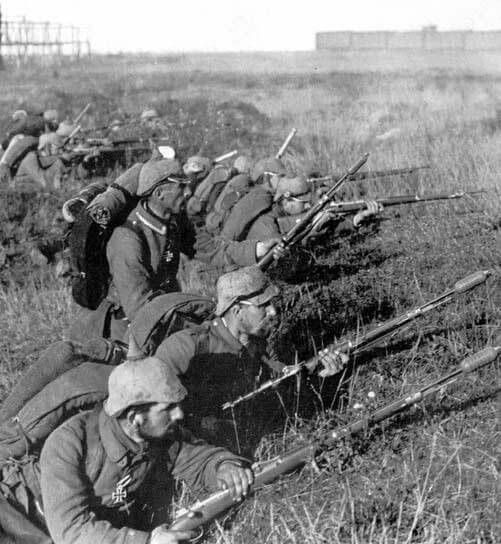
German infantry awaiting an attack during the Battle of the Marne, fought from 6th to 9th September 1914, during the First World War
Once over the Petit Morin River, the Black Watch headed north west along the north bank of the river to attack the Germans in Sablonnières. They were strongly resisted by dismounted German cavalry and the Garde Jӓger, and, only when joined in the attack by the 1st Queen’s Own Cameron Highlanders and dismounted cavalrymen, did the attack make progress, ensuring the capture of Sablonnières by 1pm.
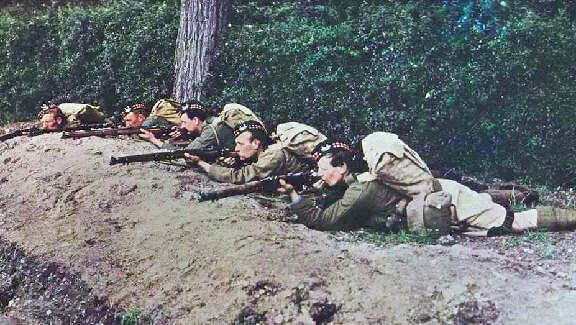
Highlanders during the Battle of the Marne, fought from 6th to 9th September 1914, during the First World War
Further to the west along the Petit Morin River, Foot Guards battalions of 4th Guards Brigade (2nd Division), 1st Irish Guards, 2nd Grenadier Guards and 2nd Coldstream Guards, with 2nd Worcesters of 5th Brigade, mounted an attack on a number of bridges in the area of la Trétoire, supported by three brigades of RFA and a heavy battery, against strong German infantry and machine gun fire, supported by artillery batteries positioned on the hill line overlooking the Petit Morin River. The fighting was confused and heavy reliance placed on the initiative of junior officers and soldiers. The British infantry forced a crossing of the river, enabling British cavalry units to cross and causing the Germans to fall back.
A party of Irish Guards captured a Guard Machine Gun company with 6 machine guns.
At around 4pm, 47th (Howitzer) Battery RFA came into action north of the Petit Morin River. The battery was fired on by German infantry in the woods. The gunners left their guns and attacked the German infantry with rifles, driving them back, and capturing 9 German soldiers.
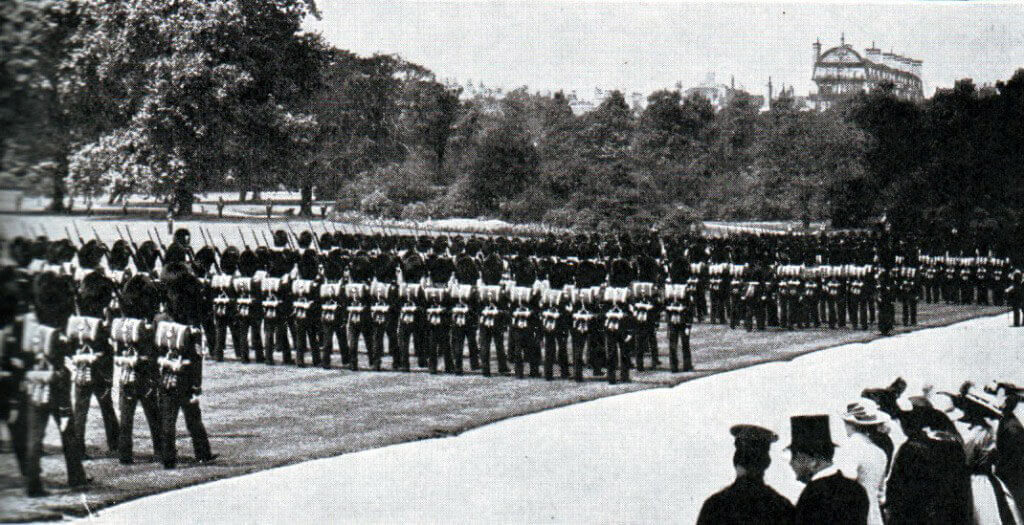
Irish Guards before the War: Battle of the Marne, fought from 6th to 9th September 1914, during the First World War
To the west of I Corps, the divisions of II Corps faced heavy German opposition in attempting to cross the Petit Morin River.
The British 5th Cavalry Brigade and the 8th Infantry Brigade attacked the Germans at Gibraltar, but could make no progress, well concealed German machine guns on the rising north side of the river continuing to hold up the attack, in spite of extensive British artillery fire.
Further west on the Petit Morin River, at 9am, the British 13th Infantry Brigade, 121st Battery RFA and the 3rd Cavalry Brigade attacked at St Cyr, but were held up by fire from German artillery concealed on the north side of the river.
On its right flank, the 14th Infantry Brigade made its advance to the Petit Morin River from Doue, to the point opposite St Ouen. Here, the attacking battalions, 1st Duke of Cornwall’s Light Infantry and 1st East Surreys, were confronted by a heavily wooded steep slope down to the river, which divided into two streams, both streams crossed by a long single bridge, covered by two German machine guns positioned on the ridge to the north of the Petit Morin River.
The two British battalions managed to cross, by a further pedestrian bridge over one stream, and a ford and boat over the other. Once over, the East Surreys outflanked the German positions and pushed them back. The DCLI moved along the river and captured St Cyr, enabling the British advance to continue.
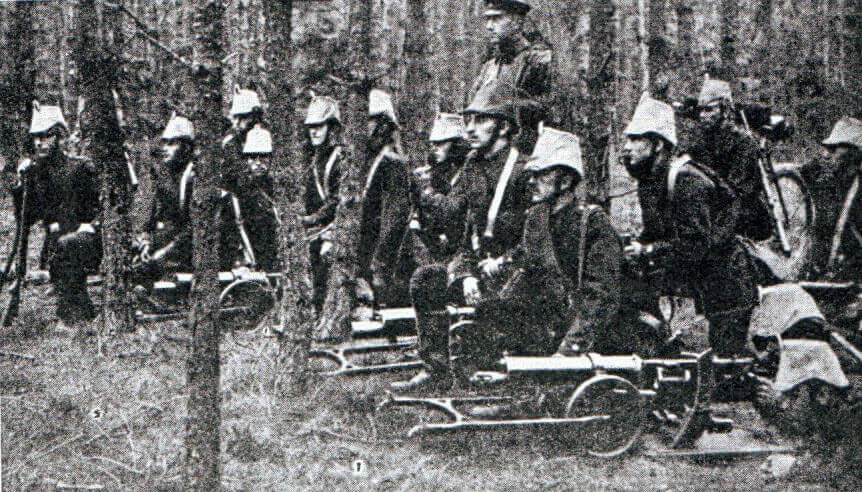
German Garde Jäger machine gunners: Battle of the Marne, fought from 6th to 9th September 1914, during the First World War
German units, 11th Cavalry Brigade and Garde Schützen, remained on the Petit Morin River at Orly, to the east of St Cyr, not having received the order to withdraw.
2nd Oxford and Bucks Light Infantry and 2nd Connaught Rangers were approaching Orly, after crossing the Petit Morin, and 4th Guards Brigade were on the main road from Montmirail to la Ferté sous Jouarre, in the rear of the Germans in Orly.
The British 60th Howitzer Battery opened fire on the Germans behind Orly, driving them back towards the main road, where they suffered heavy casualties at the hands of 4th Guards Brigade. Orly was taken soon after, by the converging 8th and 9th Brigades, falling at around 4pm.
La Ferté sous Jouarre was the key town on the left of the British advance, with a number of bridges over the Petit Morin and the much larger River Marne, the two rivers meeting in the town.
The guns of the British 4th Division began shelling German positions and artillery in la Ferté sous Jouarre at around noon, assisted by 108th Heavy Battery from 5th Division, firing off the map from Doue.
At 1pm the British 11th, 12th and 19th Brigades attacked la Ferté sous Jouarre, and, in spite of the demolition by the Germans of the two bridges over the Petit Morin, the part of the town to the south of the Marne River was taken by 8pm.
A violent thunderstorm at around 6pm severely handicapped further operations for the BEF, and they came to a close, leaving British units across the Petit Morin, and, in some instances, well on their way to the Marne River, the next obstacle in the advance to the north.
The main German formations facing the BEF, I Cavalry Corps and parts of IV and IX Corps were withdrawing to the Marne, and forming positions behind that wide river.
On the right of the BEF, the French 5th Army made good progress during the day, and stood to the north of the Petit Morin. On the British left, General Manoury’s French 6th Army was encountering difficulty dealing with the strongly reinforced German formations on the Ourcq River, and was in some places forced back.
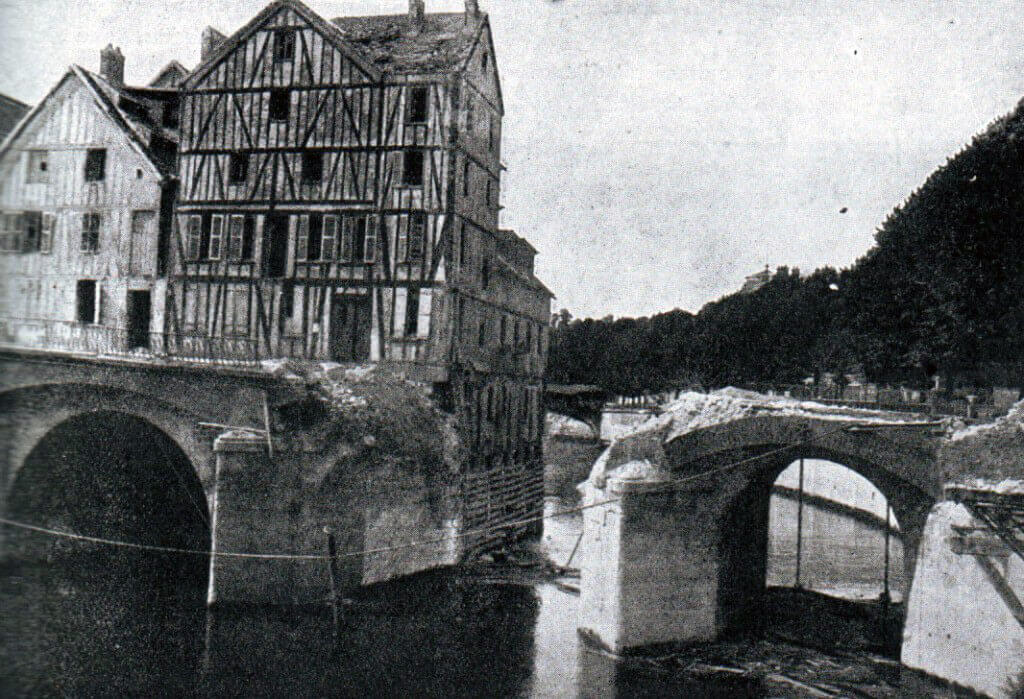
Pont du Moulin at Meaux on the Marne River, demolished by French sappers: Battle of the Marne, fought from 6th to 9th September 1914, during the First World War
9th September 1914, the Passage of the Marne River:
The orders for the BEF, on 9th September 1914, were to press forward from 5am. The expectation was that the Germans would fight on the line of the Marne River. The Marne was much wider than the rivers encountered during the advance over the previous few days, and the rising hills on the north bank were ideal for infantry positions and concealing artillery. Few bridges crossed the Marne and these could be destroyed.
The numbers of German troops concentrated along the north bank of the Marne seemed to bear out this assessment.
However, air reconnaissance by the Royal Flying Corps during the evening of 8th September suggested that the Germans were continuing to withdraw, rather than offering a strong defence along the line of the Marne.
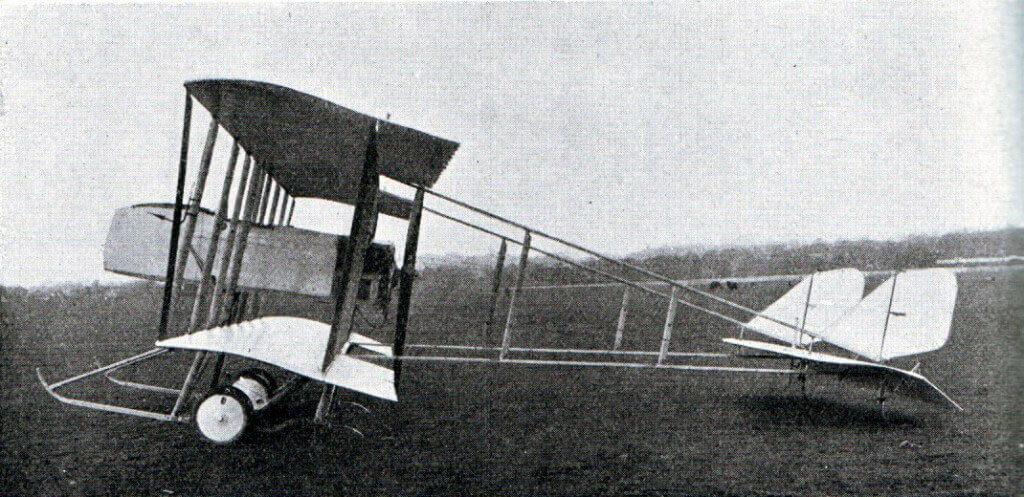
Maurice Farman ‘Gun Bus’: Battle of the Marne, fought from 6th to 9th September 1914, during the First World War
The Germans demolished the bridge over the Marne at la Ferté sous Jouarre and two bridges to the west, but not the bridges opposite the centre of the BEF advance. It would seem that this was due to incompetence.
The 6th Infantry Brigade approached the bridge at Charly. It could be seen that there was a barricade across the middle of the bridge, but no German troops holding it. A platoon of 1st King’s Liverpools approached and crossed the bridge, dismantling the barricade. The locals reported that the Germans responsible for destroying the bridge had become incapably drunk instead. The many incidents of drunkenness indicated a breakdown in German discipline.
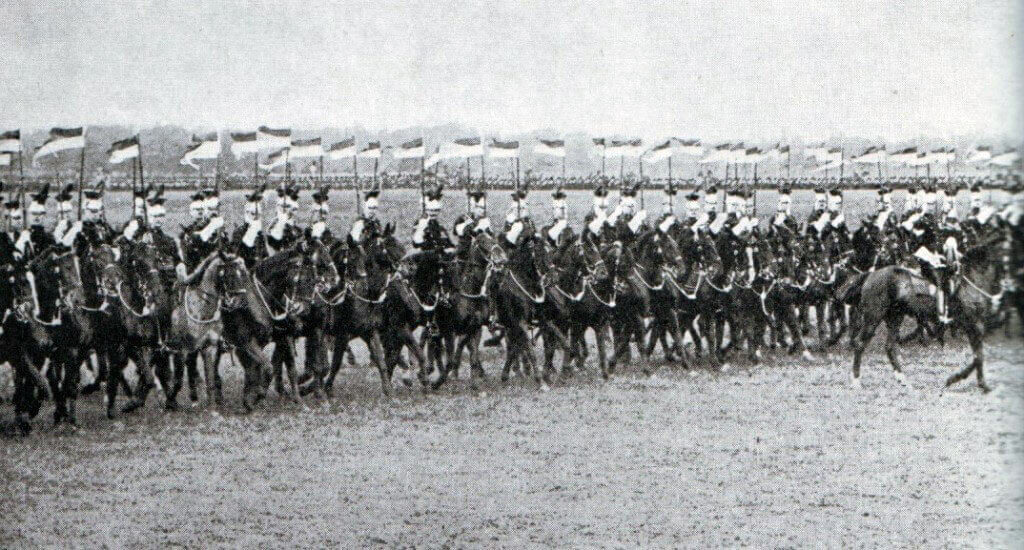
The British 5th Lancers in review at Aldershot before the war: Battle of the Marne, fought from 6th to 9th September 1914, during the First World War
By 5.30am, the British 1st Cavalry Brigade secured the bridge at Nogent, and the 4th Cavalry Brigade secured the bridge at Azy, both intact. These two brigades advanced a further three miles to provide cover for the British infantry crossing the Marne River.
Units of the British 1st and 2nd Divisions crossed the Marne in this sector and moved north, before being halted, on the receipt at GHQ of information that strong German forces were moving in from Château Thierry, further east on the Marne. In fact, there was no formed body of German troops, just small parties and columns, all moving north.
At 3pm, British RFC aircraft reported the area clear of German formations and I Corps resumed its advance up to the Château Thierry to Montreuil road. Sir John French ordered I Corps to halt there, as the French 5th Army on the right was not making an equivalent progress, and was falling behind the British advance.

The Royal Flying Corps on parade in 1914 before the War: Battle of the Marne, fought from 6th to 9th September 1914, during the First World War
To the west of the British I Corps crossing points, but east of la Ferté sous Jouarre, the Germans left bridges at Nanteuil and Saacy undemolished, and available for II Corps’ use. By 8am, the 3rd Division was across the Marne at Nanteuil, and the 5th Division was also across and attacking the heights to the north of Saacy, against heavy German resistance. This resistance, coupled with the close wooded countryside, held up the advance by the14th Brigade towards Montreuil.
West of Bezu, some miles north of the Marne River, the advanced guard of the British 3rd Division came under persistent shrapnel fire from a German battery concealed in a wooded area.
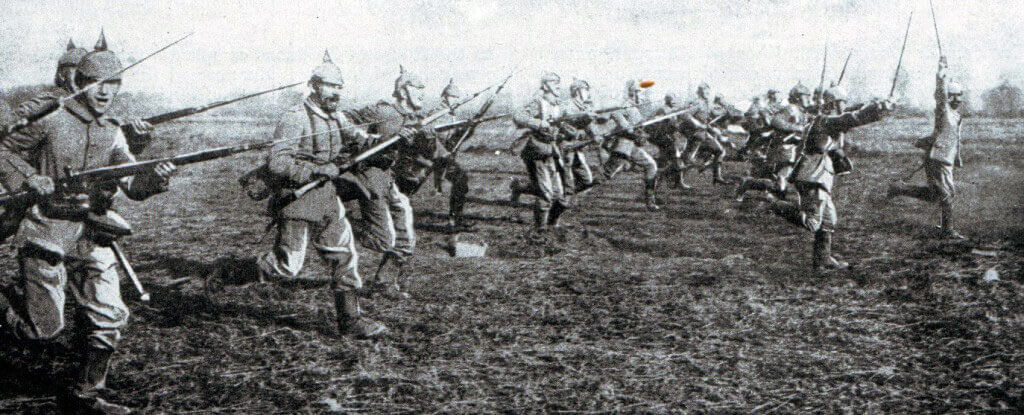
German infantry attack: Battle of the Marne, fought from 6th to 9th September 1914, during the First World War
Two companies of the 1st Lincolnshire Regiment advanced through the wood to silence the German guns, a battery of the German 46th Field Artillery Regiment. The Lincolns crept to within 150 yards of the German guns, and shot down the gunners to a man. Advancing to take the guns, the Lincolns came under fire from the German gun escort, which they overcame, and from the British 65th Howitzer Battery, mistaking the British infantry for returning German gunners. The Lincolns suffered heavy casualties from the British gun fire, and were forced to withdraw into the woods. The German guns were captured the next day.
At around 11.30am, the British 3rd Division emerged from the close wooded area, and launched attacks on the German positions around Montreuil. Heavy fighting took place, the Germans supported by artillery batteries situated on each side of the town, and the attack by the 14th Brigade on Montreuil was brought to a halt.
Attacking Montreuil from the south-east, the British 15th Brigade was halted by heavy machine gun fire and concealed German guns. At around 6pm, a German battery at Chamoust was discovered, and put out of action by the British 37th Howitzer Battery, but it was now too late to make further progress before nightfall. In addition, 3rd Division found that the units on its flanks were still well back, so, other than pushing a vanguard onto the Château Thierry to Montreuil road at Ventelet Farm, the division remained where it was, in the most advanced position of the BEF II Corps on the north side of the Marne River.
During the day, the British III Corps attempted to cross the Marne River along the stretch of river running north east to south west, forming the west side of the loop, on the east side of which the 3rd Division was advancing on Montmireuil. The only bridge available was the railway bridge towards the northern end of the loop, the others being damaged by German demolition. The strong German positions on the north side of the Marne were covered by artillery from the area of Montmireuil, firing into the III Corps right flank, and further batteries directly in the German rear.
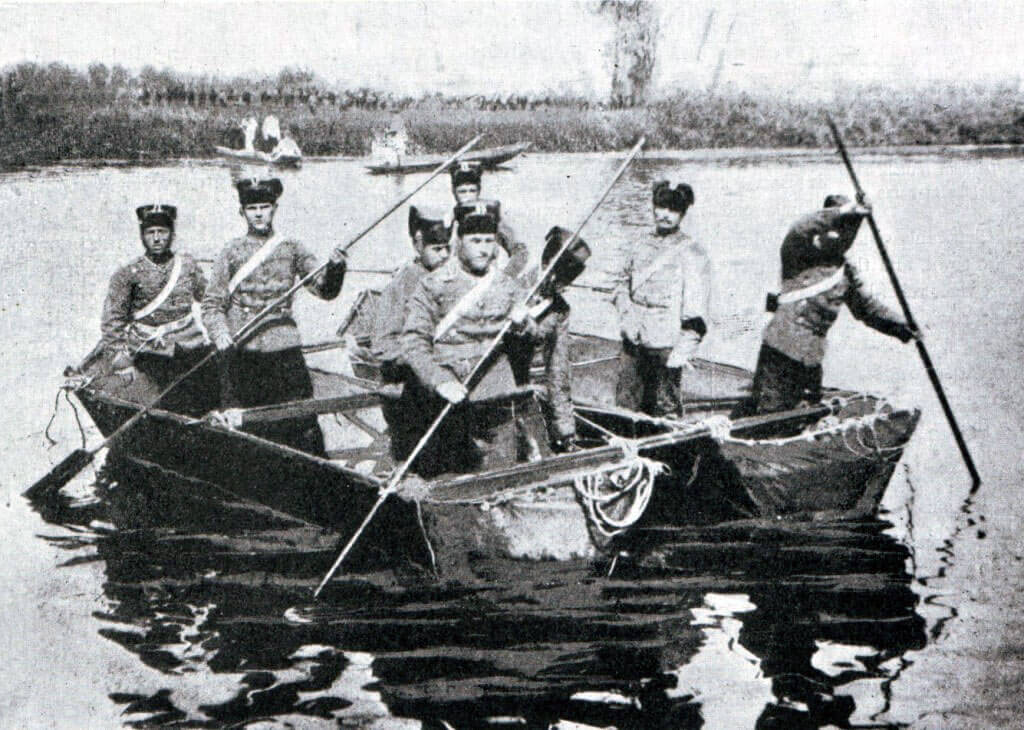
German Hussars crossing a river: Battle of the Marne, fought from 6th to 9th September 1914, during the First World War
The pontoons available to the Royal Engineers of III Corps were insufficient to cross the wide Marne River. The pontoon companies spent the day assembling additional material to complete the river span.
At 4.45am on 9th September, the British 11th and 12th Brigades launched assaults into and around la Ferté sous Jouarre, with orders to repair and cross the damaged bridges. This proved extremely difficult, as the Germans occupied many of the surrounding buildings. British artillery occupied the high ground to the east of la Ferté sous Jouarre, and began bombarding the houses identified as holding German machine guns and infantry. Attempts were also made to cross the Marne by boat to the west of la Ferté sous Jouarre. These attempts failed, in the face of strong German machine gun, artillery and rifle fire.
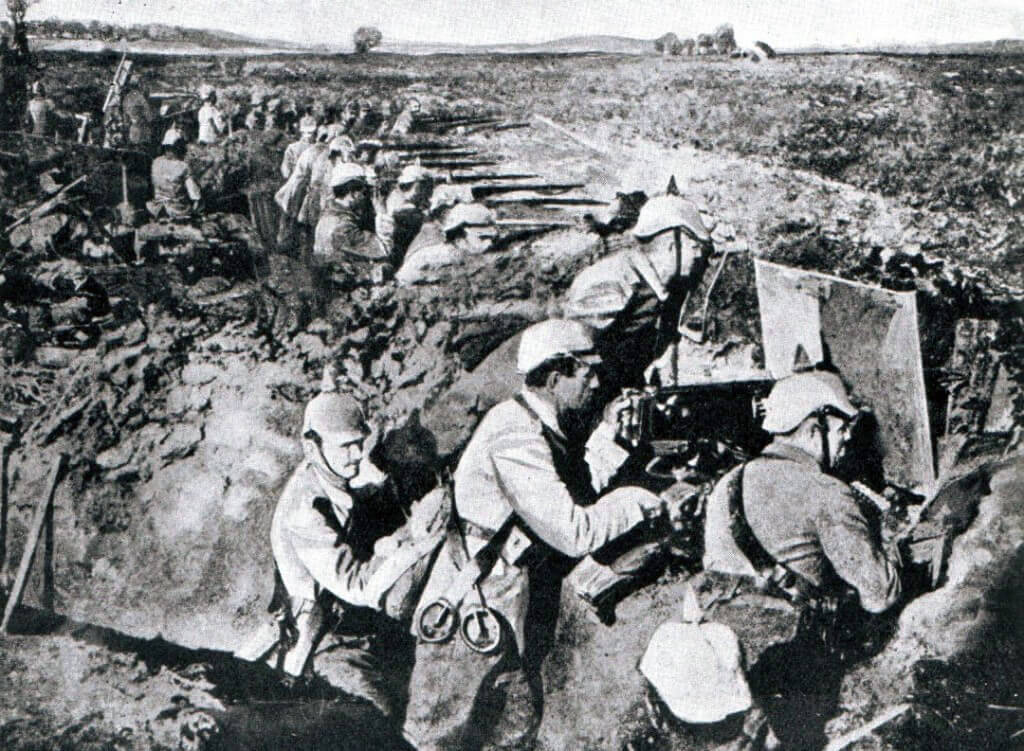
German infantry during the Battle of the Marne, fought from 6th to 9th September 1914, during the First World War
Two battalions of the British 12th Brigade, 2nd Essex Regiment and 2nd Lancashire Fusiliers, advanced up the river bank into the loop, to a weir identified from the maps. They found a lock, barrage and weir defended by German infantry, but intact. The German infantry were driven off by small arms and machine gun fire, and the British crossed the weir footbridge in single file, almost without casualty.
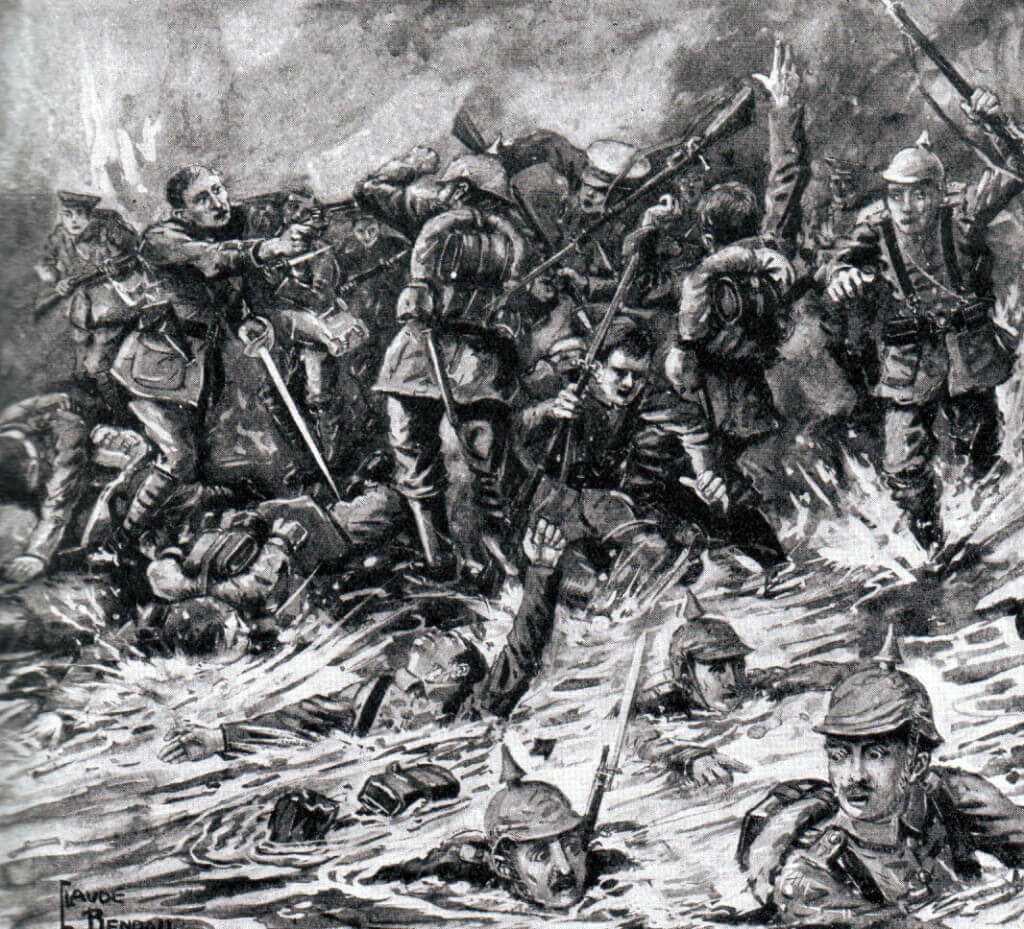
Contemporary illustration of fighting on the Marne River, with the caption ‘We killed them on the bank then we drowned them in the river’: Battle of the Marne, fought from 6th to 9th September 1914, during the First World War
The two British battalions formed up, and climbed the hill to the road from la Ferté sous Jouarre to Montreuil, but arrived too late to intercept the German retreat from la Ferté sous Jouarre.
In the meantime, the British 11th Brigade withdrew from la Ferté sous Jouarre and the town was subjected to an extensive bombardment, causing the Germans to abandon the defence of the bridges. These were inspected and repairs begun.
By evening, troops of the British III Corps were across the Marne, by boats to the west of la Ferté sous Jouarre, by way of the bridges in the town, and over the weir and by the railway bridge further north in the loop.
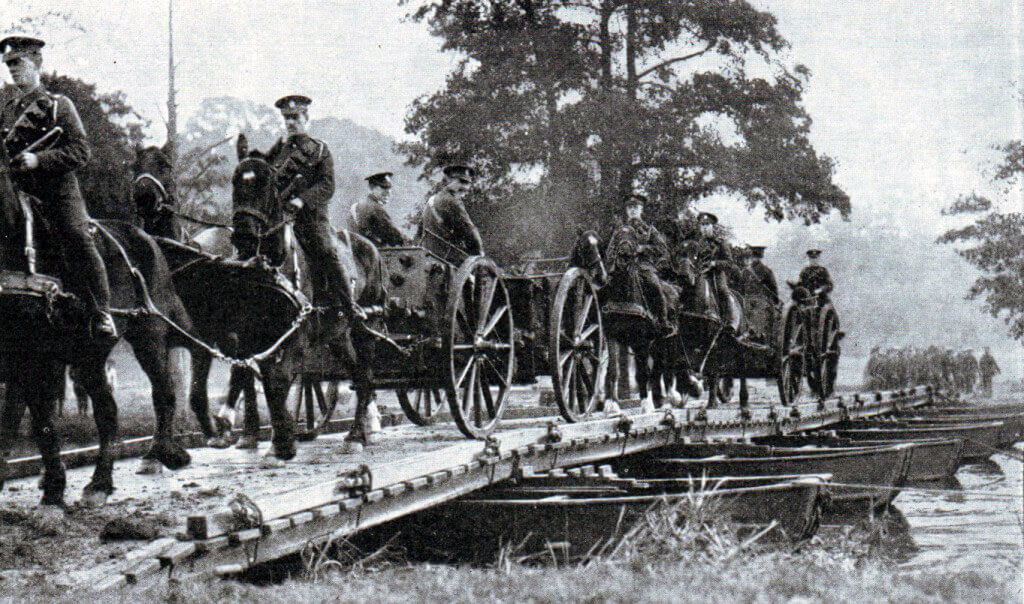
British troops crossing a pontoon bridge in 1914: Battle of the Marne, fought from 6th to 9th September 1914, during the First World War
At the end of 9th September 1914, the British Expeditionary Force occupied positions to the north of the Marne River. The Cavalry Division lay around Lucy le Bocage on the right, the most advanced of the British formations. 5th Cavalry Brigade lay at La Baudière, just west of the Cavalry Division. I Corps had advanced to a line from Le Thiolet to Couprus. II Corps lay from Bezu to Caumont. 3rd Cavalry Brigade was still south of the Marne. III Corps lay between Luzancy and Chamigny.
By around 5.30pm, air observation showed that the German First and Second Armies were carrying out an extensive withdrawal along the fronts held by General Manoury’s French 6th Army, the BEF and General Franchet d’Espèrey’s French 5th Army to its right.
The Battle of the Marne was ended and the Battle for the Aisne about to begin.
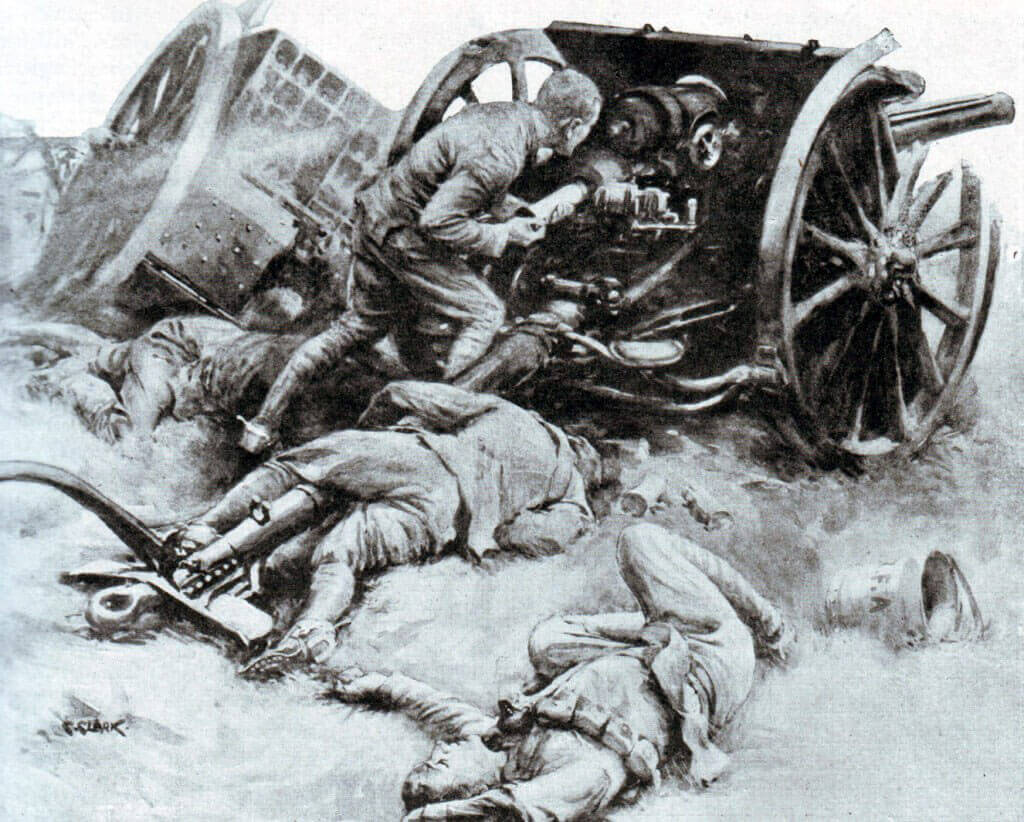
British 18 pounder in action in France 1914: Battle of the Marne, fought from 6th to 9th September 1914, during the First World War
Casualties at the Battle of the Marne: The casualties of the BEF for the whole war up to 10th September 1914 were 12,733. The casualties in the advance to the Marne during the period 6th to 10th September 1914 were 1,701. The French lost around 250,000 men in the period of the war up to 10th September 1914. German casualties for this period are unknown, but are likely to have been similar to the French. The BEF captured 13 guns, several machine guns (7 were taken by 4th Guards Brigade from the German Garde Jӓger on 8th September 1914) and 2,000 German troops.
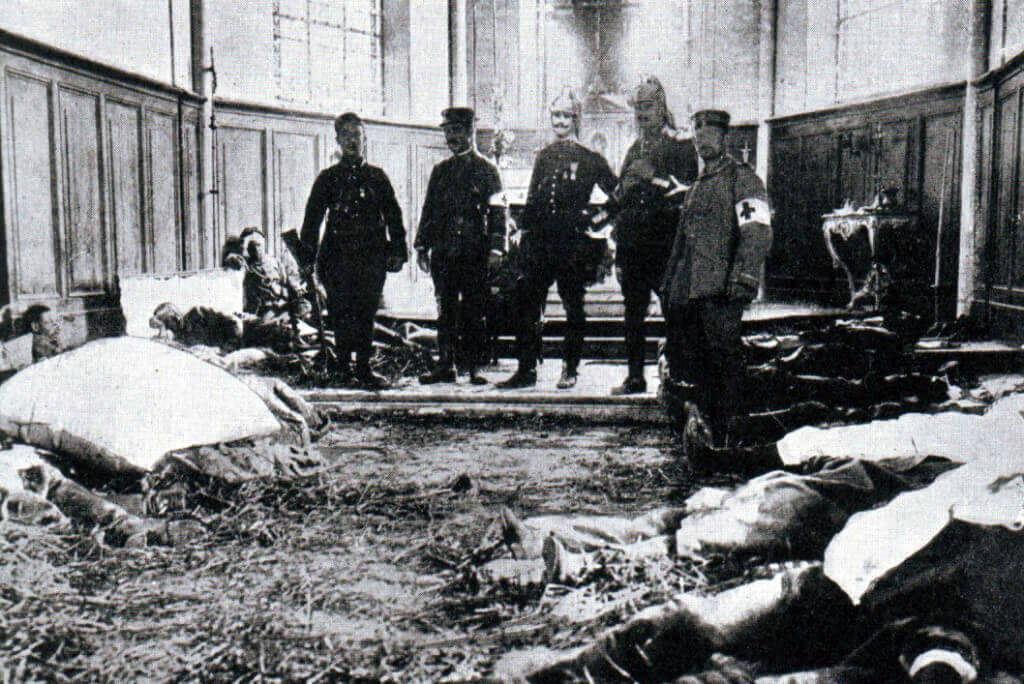
Church near Meaux, used as a hospital for French and German casualties: Battle of the Marne, fought from 6th to 9th September 1914, during the First World War
Aftermath of the Battle of the Marne: The Battle of the Marne saw the German attempt to steam roller the French and British armies, and win the war in a month signally fail. Instead, the German Army was forced to fall back a considerable distance to the line of the Aisne River, broadly the line between the opposing sides until early 1918. General von Moltke was secretly removed as German Chief of Staff.
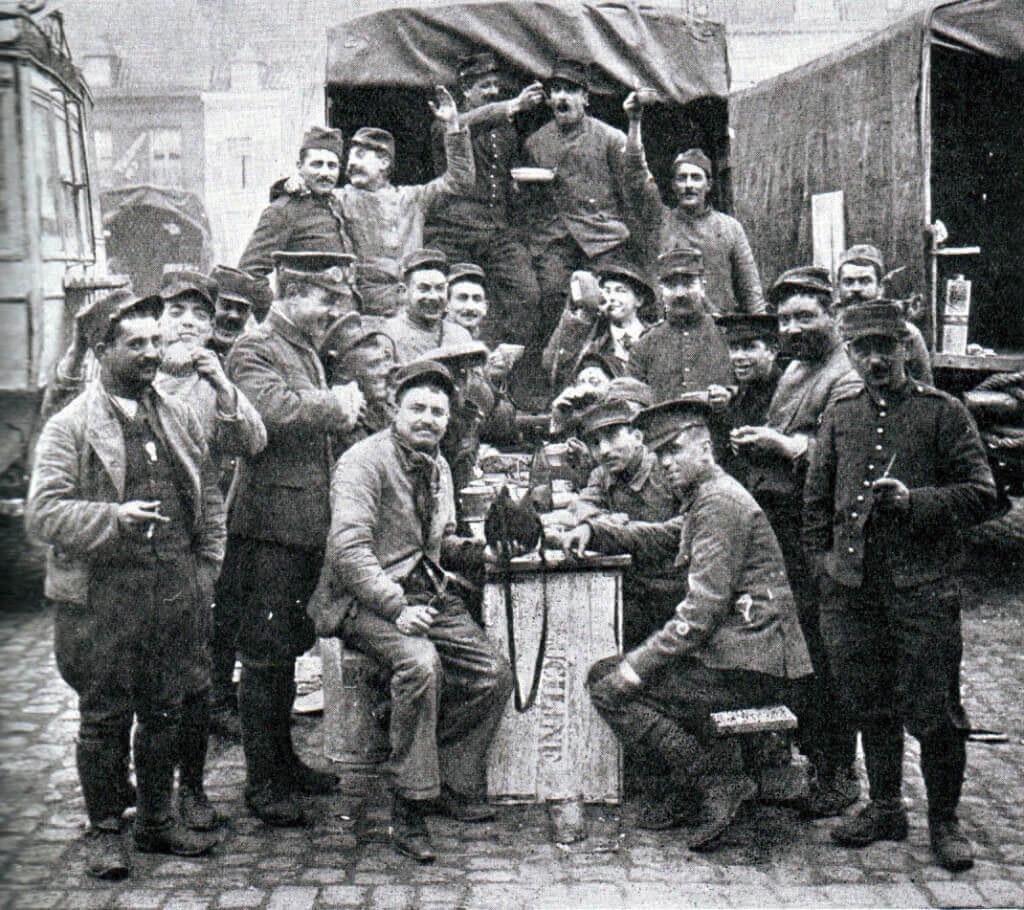
British and French troops during the Battle of the Marne: Battle of the Marne, fought from 6th to 9th September 1914, during the First World War
Decorations and campaign medals for the Battle of the Marne: see the entry for the Battle of Mons.
Anecdotes and traditions from the Battle of the Marne:
- It is hard not to admire the panache and resource of the BEF’s units during the Battle of the Marne, in contrast to the poor morale and inefficiency of the hitherto victorious German Army.
- One of the companies at the Royal Military Academy Sandhurst is named ‘Marne Company’, in appropriate acknowledgement of a major British victory.
- A letter written by a dead German officer, and found on him during the battle, stated: “German infantry and cavalry will not attack English infantry and cavalry at close quarters. Their fire is murderous. The only way to attack them is with artillery.”
- During the fighting on the Petit Morin River, the Irish Guards had experience of German troops waving white flags, and then firing on the British soldiers advancing to take their surrender. Behaviour like this no doubt led to the informal policy in British Foot Guards battalions later in the War of not taking prisoners.
- The Coldstream Guards history records, of the German troops: ‘The march of the 4th (Guards) Brigade lay through Rebais….. Shops had been looted, bottles, crockery, furniture etc lay scattered about ….The inhabitants reported that there was much drunkenness among the Germans, and the vast number of empty bottles that littered the country near the roads along which they were retreating gave ample proof of their demoralisation.’
- The aircraft of the Royal Flying Corps flew large numbers of reconnaissance missions over the German positions, and over the advancing British and French formations, so that the generals could be informed where their own and the enemy troops were, and in what direction they were moving. The aircraft identified German positions to the British artillery for bombardment, by flying specific patterns over identified German units: for example, two circles indicated the presence of German infantry beneath the aircraft.
- General Smith-Dorrien spoke to a group of infantry re-enforcements marching up to join their regiments, on Tuesday 8th September 1914. He told them that, even though their men were tired, they only had to march a further nine miles and they would be joining the pursuit of the Germans and earn a battle clasp.
- A battery commander of a 1st Division RFA battery determined, during the fighting, to capture two German machine guns his guns had put out of action. The major led a mounted party, of his trumpeter and nine gunners, in a dash through the woods, under fire from several points, until he found the machine guns, captured them from the surrounding German units and brought them back into the British line. Watching British infantry described the Gunners as ‘mad’.
- On 6th September 1914 the Irish Guards marched through Rozoy. The parish priest was standing at the door of his church, as the battalion passed. To his surprise the guardsmen removed their hats in deference to him. The priest gave them a blessing.
- The Grenadier Guards history of the war records that the weather began to change during the Marne Battle, the hot summer giving way to wet cold evenings. The soldiers began to regret discarding the greatcoats that had seemed such an unnecessary encumbrance during the Mons Retreat.
- Frank Richards, a regular private in 2nd Royal Welch Fusiliers of 19th Brigade, wrote in ‘Old Soldiers never die’ of the Battle of the Marne, ‘Our rations were very scarce at this time. Bread we never saw; a man’s daily rations were four army biscuits, a pound tin of bully beef and a small portion of tea and sugar. Each man was his own cook and we helped our rations out with anything we could scrounge. We never knew what it was to have our equipment off and even at night when we sometimes got down in a field for an all-night’s rest we were not allowed to take it off.’
References for the Battle of the Marne:
- The Official History of the Great War by Brigadier Edmonds August-October 1914.
- Times History of the Great War
- Mons, The Retreat to Victory by John Terraine.
- The First Seven Divisions by Lord Ernest Hamilton.
- History of the 2nd Division 1914-1918 Volume 1 by Wyrall
- The Grenadier Guards in the Great War of 1914-1918 Volume 1 by Ponsonby
- The Coldstream Guards 1914-1918 Volume 1 by Ross of Bladensburg
- The Irish Guards in the Great War 1st Battalion by Rudyard Kipling
The previous battle in the First World War is the Battle of Villers Cottérêts
The next battle in the First World War is the Battle of the Aisne
